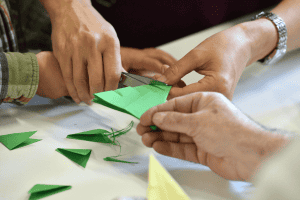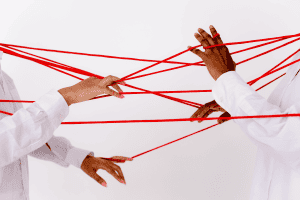15 Benefits of Relationship-Building Activities

Working together towards a common goal is one of the critical factors in an organization’s success. To achieve that, having strong relationships between team members is crucial.
Relationship building can help improve communication and understanding, making working together more productive and enjoyable. There are many ways to build relationships within Agile teams, and one of them is through team relationship-building activities.
In this blog post, we will discuss the benefits of team building and share tips on how to build relationships within an Agile team. We’ll also share some of the best Agile games you can play within your organization.
5 Benefits of Relationship Building in Agile Teams
1. Improves communication and understanding
When agile team members have strong relationships, they are more likely to communicate effectively and understand each other’s perspectives. It can lead to more productive conversations and a better understanding of the goals of the agile team.
2. Enhances collaboration
Agile Teams that have good relationships tend to collaborate quickly and effectively. Strong relationships encourage team members to trust each other and work together towards a common goal.
3. Boosts team morale and happiness
Happy employees are usually more engaged and productive at work. When agile team members have strong relationships, they feel connected and belong, boosting morale and happiness at work.
4. Reduces conflict in the team
When agile team members have good relationships, they are more likely to resolve conflict constructively. When team members trust and respect each other, they are less likely to let disagreements escalate into arguments.

5. Improves quality of work
Solid relationships within the team usually result in high-quality work. Agile team members feel comfortable asking for help and offering feedback to each other. With contributions from every member, the team can identify and solve problems more effectively.
5 Tips for Building Relationships in an Agile Team
1. Get to know each other
One of the fastest ways to get to know each other is to take the time to learn about their backgrounds, interests, and goals through conversations. This can also be done by observing how each member works and interacts with others.
2. Communicate openly and honestly
Effective communication is essential for any relationship. It means being clear about your expectations, giving feedback constructively, and listening to other team members. In an Agile team, every team member should communicate openly and honestly to build trust.

3. Be supportive
In any organization, supporting each other to achieve the team’s goals is crucial. Support means offering help when someone is struggling, celebrating each other’s successes, and understanding when things don’t go as planned.
4. Respect each other
Each team member should respect the other’s ideas, opinions, and expertise. Everyone should be open-minded, value each person’s contributions, and maintain a positive attitude.
5. Have fun together
Organizing social events, participating in team-building activities, or spending time together outside work can be fun.

5 Best Relationship-Building Activities You Can Do With Your Team
1. Two Truths and a Lie
This team-building game is a great icebreaker and can be used to get to know your team members more personally. The agile game gives the team a chance to know each other’s strengths and weaknesses so they can find ways to help.

Mechanics:
- Each team member takes turns making three statements about themselves, one of which is a lie.
- The rest of the team must guess which statement is the lie.
- Once everyone has answered, the person who gave the three statements should reveal the correct answer.
2. Human Knot Game
This team-building activity strengthens communication within the team and improves efficiency and bonding as each team member becomes reliant on the others to reach a common goal.
Participants must practice their problem-solving skills in this agile game. The more comfortable the members are with each other, the easier it is to establish a solid foundation of trust.

Mechanics:
- The group stands in a circle and reaches for the hands of those across from them.
- After everyone is linked, the team must attempt to untangle themselves to form a circle without breaking the chain of hands.
- The team should begin again if the chain of hands breaks at any time.
3. The Perfect Square
This team-building game is an excellent way to practice leadership and develop team consensus. It is one of the many team-building activities that reflect each member’s approaches to problem-solving and how well the group dynamics accept or reject suggestions.

Mechanics:
- Team members must form a perfect square while blindfolded. The entire team must work together to achieve this.
- Everyone should hold the rope and stand in a circle. Once all participants stand in a circle, the team can place the rope on the floor.
- Each person puts on a blindfold and takes five steps from the rope. Once they are blindfolded, the team may begin the activity.
- The activity is completed when the group believes they have already created a square. Participants remove their blindfolds, and the final result is revealed to them.
4. Collaborative Origami
Collaborative Origami demonstrates how ambiguous communication and discounting techniques may fail to achieve desired results. This team-building activity emphasizes how collaboration leads to a better quality of work and faster results.
The key focuses of this team-building game are cross-functional collaboration, creativity, listening skills, and effective communication.

Mechanics:
- Pairs in the group are given instructions and a sheet on creating origami.
- In the first round, they sit back-to-back and attempt to finish origami, with one team member giving instructions while the other does the folding.
- In round 2, the pairs sit face to face and attempt to create origami, but the folder can’t see the directions.
- For the final round, both pairs sit side-by-side and can see what is happening and what instructions to follow.
- The team must assess which of the three scenarios best accomplishes the task.
5. Things In Common
This team-building game is a jumping-off point for a brainstorming session to unite the team. It is a powerful approach to encourage cohesion and foster strong inter-departmental relationships, resulting in connected, committed, and engaged staff.

Mechanics:
- Divide the team into small groups and give them ten minutes to develop a list of ten items they have in common.
- They throw a string at each other when they have something in common.
- At the end of the activity, there will be many intertwining strings, and the team will realize they have a lot in common. This is the primary purpose of the exercise.
Conclusion
Relationship building is vital in an Agile team because it helps improve communication and understanding between team members. It also allows for a more cohesive team that can work together better.
Games are one fun way to build better relationships within your team. Agile team-building games and activities help to develop good communication and understanding between team members, which leads to a more cohesive and productive team.
If you feel your team needs to work on its relationships and connections, consider playing team-building games together so you can have fun and build solid foundations for your team at the same time.

